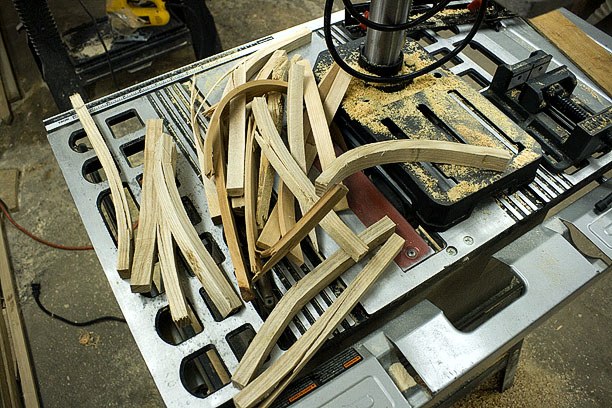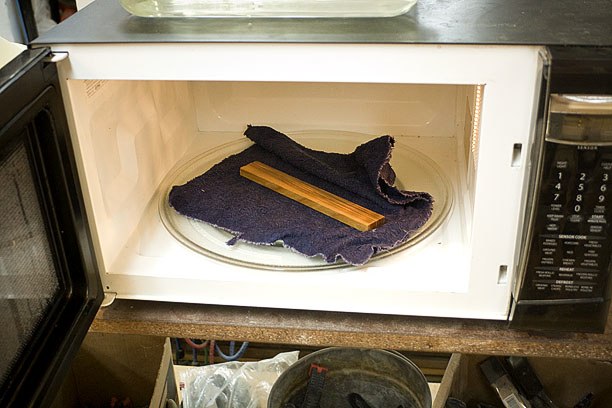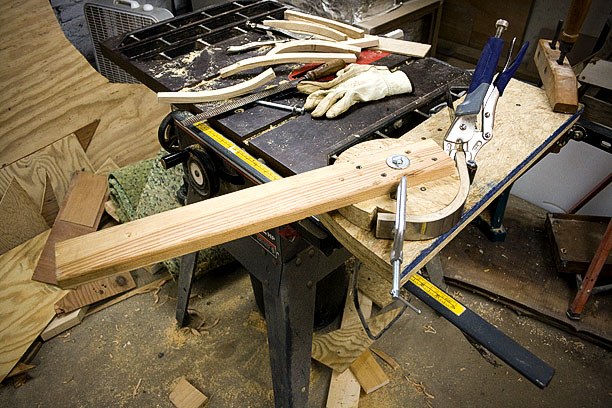This was a good weekend, spent bending many pieces of wood into pretty shapes. There was a lot of free time between steps, so I could play with the video camera some. The video above shows the whole process better than I could describe it. If you want to see it in HD, there’s a version on Youtube here:
Barto’s plans call for steam bent Ash as knees to support the side decks. I’ve never seen a Melonseed that actually has them. All the builders I know used sawn knees. Now that I’ve tried it I understand why. Done properly, I imagine the sawn knees may even be stronger, and certainly must be quicker.
These side knees are rather short pieces, and in Barto’s plans are made of two parts: a flat wide piece that conforms to the shape of the hull to form a solid base, and then the more deeply curved but thinner piece that angles down from the coaming to attach to the base, which actually provides the support.
Since these pieces are small enough to fit in our big microwave I decided to give it a try.
A long time ago, I knew a wood turning craftsman who created works both beautiful and unique. He turned green wood on a lathe into thin, delicate bowls and vases. Then he microwaved them wet, and, while the wood was still hot and steaming, would warp and pucker them into intricate sinuous shapes. The forms were fascinating and elegant, and the idea has always stayed with me. I didn’t have a great experience with a conventional steambox last time, and since these pieces are small enough to fit in our big microwave I decided to give it a try.
(This is what I was going to start last weekend when the power went out. Yesterday, after everything was set up and ready to go, literally as I reached to punch the Start button on the microwave, I heard two distant explosions – two transformers – and, you guessed it, the power went out. Moments later, sirens. Then, fortunately, the power came back and stayed on.)
There’s surprisingly little information on the web about steam bending that I could find at all. What you can find is often interesting, but not much good for details on how to do it. There’s even less on using a microwave. Ok, almost none. But, after a couple of frustrating evenings of trial and error, I came up with a combination that works really well. This is what I found out, so if it helps someone else, great.
 Bentwood kindling. Lessons learned the hard way.
Bentwood kindling. Lessons learned the hard way.
I did learn that it’s not the steam that makes it possible to bend wood – it’s the heat – which is why a microwave works. Heated to near boiling, the wood softens like plastic, then rehardens as it cools. The wood does have to be moist, though. Steam heat is more efficient at heating stuff than dry heat, and reduces the loss of moisture when wood is hot for a long time.
 Soaking the wood for several days in advance.
Soaking the wood for several days in advance.
The advantage of a microwave oven is speed. IF you use green wood, or soak dry wood for several days in advance, the microwave will heat the wood very quickly, before it has a chance to dry out. It literally turns the water within the wood to steam. In fact, it heats it so quickly that if you’re not careful it will boil the water off and char the wood in seconds. The first piece I tried turned to charcoal, from the inside out.
 A wet piece of towel helps diffuse the energy
A wet piece of towel helps diffuse the energy
to heat more evenly, and holds in the steam.
The key, I learned the hard way, is to get the timing right. The time can vary, depending on the size of the wood and the power of the microwave – they are all different. A minute to a minute and a half on High was right for our new oven; the old one would have taken more than two minutes. And you might want to do this while the primary cook is out of the house for a while, long enough to clear out the smoke if necessary.
Most important is to use a bending strap. This strap is the key to successful wood bending, regardless of your heat source. Only a few very old documents I found made reference to it, but it’s what made the mass production of bentwood chairs possible in the late 19th Century, the ones that appear in so many Impressionist paintings. It was considered the first modern chair, and they were favorites of artists like Picaso and Monet.
I used a tempered stainless steel ruler for my strap, since it was the right width. Without it, every piece I tried to bend broke. With it, very few broke, and those were the scrap pieces with grain runout or other odd flaws. Wood doesn’t stretch. When bent into a curve, the outer edge is pulled apart, and this is what causes the wood to snap or split, no matter how hot or wet it is. But heated wood will compress, and that’s where the bending strap comes into play. When clamped on tight along the outside edge, it prevents the wood from stretching, and forces the inside edge to compress.
With 24 pieces to bend, it made sense to build a jig, and this helped, too. Especially since these pieces are small and hard to bend by hand. When you want to break up sticks for firewood, you do what? Bend it over your knee, of course. It’s the easiest way to break a piece of wood – apply all the pressure at one point in the middle. So don’t do that if you want the wood to bend instead of break. Apply controlled pressure along the whole piece of wood, not putting too much on any one place. A rolling jig helps with that.
 Bending jig, close up, with strap.
Bending jig, close up, with strap.
Once the wood is bent around the jig, let it cool completely. Then, if you’re careful, you can move it off the jig to another form. Let it dry on the form for at least day or two; less if you use heat or have good air circulation.
There’s some spring back when removed from the forms. In this case, I want to install the knees under light pressure, so that’s OK. Also, each piece is a little oversize and takes on a slightly different bend all its own. I’ll shuffle them around the different locations until I find the best fit for each piece, then cut to size. The slight spiral shape of the curve will help, allowing me to cut the final piece out of the blank to include the curve that suits the location. In most cases I overbent the wood some, and expect to use a heat gun to open them a little to the final curve for a good fit.
melonseed skiff, mellonseed skiff, melon seed, mellon seed



You either have way too much time on your hands or you really want to learn how to do all of these kind of things. Speaking of which, your rolling pin mast sander really works. We made one and have used it.
Thanks Dave
Monday, May 17, 2010 – 04:27 PM
thank you – i’ll give it try
Friday, May 6, 2011 – 09:52 AM
I’ve been messing around with steam bending with a microwave for a while, but I’ve never been able to be 100% successful. This is awesome. What I was doing wrong was not soaking the pieces (which are comparable in size to what you’re dealing with here). Thanks for posting your findings…they have made this pipemaker a must less frustrated craftsman…
オークリー rb3183
I am an artist I am sur one day i will need to steam bend wood .Your video is awesome thank you for the post